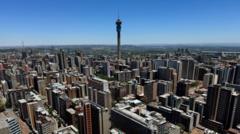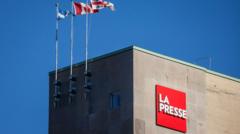In the wake of crime struggles and urban decay, Johannesburg is witnessing a renaissance fueled by local organizations and strategic developments aiming to reshape the narrative around one of the world’s most challenging cities.
Revitalizing Johannesburg: A Transformation Story from a Dangerous Past

Revitalizing Johannesburg: A Transformation Story from a Dangerous Past
Hope reignites in Johannesburg through urban regeneration efforts and community initiatives.
The view from the summit of Ponte Tower offers a striking contrast to its storied past. Once considered a hotspot for crime and neglect, this iconic Johannesburg structure, established in 1975, stands as a testament to resilience and renewal. Delving into its historical context, Delight Sithole, a local tour guide, recounts, “The building got hijacked. There were no utilities, so most of the people were actually throwing their trash right inside the building, until it reached the 14th floor.” Abandoned to the mercy of criminal gangs in the 1980s, Ponte Tower was synonymous with urban blight and insecurity, embodying Johannesburg’s notorious reputation for danger.
However, the landscape began to shift significantly around 15 years ago, coinciding with South Africa's hosting of the FIFA World Cup. The gradual reclamation of the area saw a resurgence in residents choosing to call Ponte Tower home again. Despite persistent crime concerns and the challenges posed by a water crisis and urban fires—such as the devastating incident in 2023, which claimed almost 80 lives—the spirits of community organizers and business leaders aim to turn the tide of the city’s narrative.
One of the critical players in the ongoing revitalization is Ithemba, a property development company that has adopted a name meaning “hope” in Zulu. Senior manager Alan Tait notes, “The demand is just phenomenal, and that demand is specifically to live in the CBD,” highlighting the renewed interest in urban dwelling within the central business district of Johannesburg. Within the last five years, the company has nearly doubled its property leases and is looking to further expand its footprint in the vibrant jewel of Jewel City, an area previously mired in disrepair.
In tandem with these developments, initiatives like JoziMyJozi are aiming to create a more inviting urban environment through community-driven projects. Bea Swanepoel, CEO of JoziMyJozi, emphasizes the transformative impact of visible improvements, stating, “By bringing hope back, we need to show some visible improvements and impactful projects so that they can see there’s a way out of where we are currently.” Their efforts span numerous aspects, aiming to tackle issues such as infrastructure deficits, homelessness, and safety concerns.
As the G20 prepares to convene in Johannesburg later this year, local leaders are optimistic about the influx of investment and international attention that may come as a result. The initiative to uplift the city embodies not just economic aspirations but a broader vision for social rejuvenation and cultural pride.
Reflecting on the transformation, Sifiso Zikhali of Dlala Nje, a community organization, proclaims, “This is our city, and whatever we face, we need at the end to find a solution for it.” While acknowledging the journey ahead, he sees hope for Johannesburg to reclaim its place among global cities like London, Paris, or New York.
As urban transformation continues to take shape in Johannesburg, it sparks a conversation about the resilience of communities and the potential for rebirth amid adversity.
However, the landscape began to shift significantly around 15 years ago, coinciding with South Africa's hosting of the FIFA World Cup. The gradual reclamation of the area saw a resurgence in residents choosing to call Ponte Tower home again. Despite persistent crime concerns and the challenges posed by a water crisis and urban fires—such as the devastating incident in 2023, which claimed almost 80 lives—the spirits of community organizers and business leaders aim to turn the tide of the city’s narrative.
One of the critical players in the ongoing revitalization is Ithemba, a property development company that has adopted a name meaning “hope” in Zulu. Senior manager Alan Tait notes, “The demand is just phenomenal, and that demand is specifically to live in the CBD,” highlighting the renewed interest in urban dwelling within the central business district of Johannesburg. Within the last five years, the company has nearly doubled its property leases and is looking to further expand its footprint in the vibrant jewel of Jewel City, an area previously mired in disrepair.
In tandem with these developments, initiatives like JoziMyJozi are aiming to create a more inviting urban environment through community-driven projects. Bea Swanepoel, CEO of JoziMyJozi, emphasizes the transformative impact of visible improvements, stating, “By bringing hope back, we need to show some visible improvements and impactful projects so that they can see there’s a way out of where we are currently.” Their efforts span numerous aspects, aiming to tackle issues such as infrastructure deficits, homelessness, and safety concerns.
As the G20 prepares to convene in Johannesburg later this year, local leaders are optimistic about the influx of investment and international attention that may come as a result. The initiative to uplift the city embodies not just economic aspirations but a broader vision for social rejuvenation and cultural pride.
Reflecting on the transformation, Sifiso Zikhali of Dlala Nje, a community organization, proclaims, “This is our city, and whatever we face, we need at the end to find a solution for it.” While acknowledging the journey ahead, he sees hope for Johannesburg to reclaim its place among global cities like London, Paris, or New York.
As urban transformation continues to take shape in Johannesburg, it sparks a conversation about the resilience of communities and the potential for rebirth amid adversity.






















